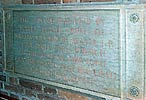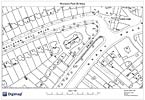For this church:    |
Wollaton Park St MaryHistory
The Middleton family sold their Wollaton Hall estate, including the hall, to Nottingham Corporation in 1924. The hall, and part of the estate, were retained for public purposes, but land on the periphery of the estate was released for building, both private and public. It included Middleton Boulevard. A garden suburb was built in the area which is now the western end of Middleton Boulevard. The houses were designed by T.C Howitt F.R.I B.A. The whole area was being developed and plots of land were sold so that private houses could be built. Adams Hill, Oundle Drive, and Wollaton Hall Drive were all developed with large private houses. They were occupied by leading industrialists and prominent people in the life of the city of Nottingham, partly because of ease of access to the city centre. Proposals were put forward to build a church hall on land purchased from the corporation, but Mr William Player, of the local tobacco company, provided funding which made it possible to buy land enough to build a church, church Hall and vicarage. The foundation stone was laid on Saturday 24 July 1937. Hundreds of parishioners from Lenton and Wollaton Park attended the ceremony. The officiating clergy were Bishop Neville Talbot from Southwell, the Archdeacon of Nottingham Rev H.V Turner, and the Rev R.J.R. Skipper vicar of Lenton parish church. Also attending were the Lord Mayor of Nottingham Coun. E Purser, Sir Albert Ball and Lady Ball, Mr. W.G. Player and Mrs Player and Sir Louis Pearson. Howitt presented Mrs Player with a trowel after she had laid the foundation stone. On the wall behind the font there is a plaque commemorating this act with the following inscription: 
The joint choirs of Holy Trinity and the Priory Church, Lenton, sang at the service. Originally the area which formed the parish was part of Sherwood Forest, and included the lost village of Sutton Passeys, which was given to Lenton Priory in 1307. John Passey became Lord of the Manor and the village became Sutton Passeys. In the 1930s it was thought to have been in the area where Sutton Passeys Crescent was laid out, and so the name of the lost church, St Mary’s, was the name adopted for the new church. Michael de Lyndeley was the first priest and there is a list of priests up to 1535. This church was later recorded as being totally decayed. (It is now known that the original village was closer to the Crown traffic island at the junction of Middleton Boulevard and Ilkeston Road, and not in the Sutton Passeys Crescent area.) Howitt was nominated as the architect of the new church. Player, on a visit to Bournemouth, saw a church which he liked. It was very light with no transepts. Howitt followed this lead and designed St Mary’s to be high and light. The bricks are light coloured, and came from William Cliffe of Stamford. The woodwork is light coloured oak. There is a semi-circular coffered ceiling. The builder was Mr H Butler and Messrs Wippell and Co were the church furnishers. It was designed to accommodate 440 people. The church was opened by the Bishop of Southwell in 1938. He led a procession round the church singing the hymn 'The Church's one foundation' He then knocked on the door with his staff and the door was opened by the curate in charge, the Rev Alan Weir. The key was then given to the Bishop. In his sermon the Bishop expressed a hope that the church would be used by the people moving to live in the area.
In 1954 the Rev Skipper died suddenly and there was a growing feeling among the congregation that they would like to be a separate parish. It was decided that the University of Nottingham should come under the parish of St Mary’s Nottingham and the church in Wollaton Park would be licensed for marriages. The first wedding was held in March 1955. The Rev E.A. Strickland became the first vicar of the independent parish. He was also the vicar of St Barnabas, Lenton Abbey. This event is commemorated on a tablet dated 29th November 1956. Tribute was also made to Mr W.G. Player who had died aged 93 years and whose generosity had led to the building not only of the church but also the vicarage and the church hall. Shortly after St Mary’s was consecrated the Second World War began and the church faced many difficulties. All the windows had to be blacked out. The Rev Alan Weir led the prayers for the men who had left home on active service. In October 1945 St Mary’s Youth Fellowship was started with 20 members. In 1946 there was a campaign of Christian Witness to make contact with irregulars. In 1962 a scout group was formed and Mr L Winstanley was appointed group leader. Over the years the heating has been a problem and an oil fired boiler was installed. In 1963 the pupils of the local school; made two white damask kneelers for use at weddings and a new altar cloth was embroidered depicting various motifs from the east window. In 1971 morning service was recorded on Radio 4 with Dr William Neill as the preacher. During 1974 the vicar made several broadcasts, and was also the Lord Mayor's chaplain. In November 1984 approval was given for the beneficences of St Mary’s and St Barnabas to become one benefice to be held in plurality by one incumbent, although they have subsequently been split again. |







